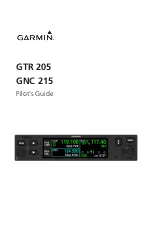
History of Revisions
July 1995
Original Release
August 1995
Revision 01
April 1996
Revision 02 (Version 5.0
software)
February 1997
Revision 04 (Version 5/6.1
software
)
Ordering Information
To receive additional copies of this Precedus GPS User’s Guide, order
part #560-0110-04. The Precedus Quick Reference Guide is part
#560-0115-01.
vi
Important Notice
The Global Positioning System (GPS) is operated by the United States Department of Defense which is solely
responsible for the accuracy, daily operation, and maintenance of the satellite constellation. System accuracy is
affected by the Department of Defense’s Selective Availability (SA) and the Dilution of Precision (DOP)
attributed to poor satellite geometry.
This product is not intended for use as a sole source of navigation information. Exclusive reliance on this device
in any navigation application is discouraged.
FCC Notice
This equipment has been tested and found to comply with the limits for a Class B digital device, pursuant to part
15 of the FCC Rules. These limits are designed to provide reasonable protection against harmful interference in a
residential installation. Operation is subject to the following two conditions: (1) this device may not cause
harmful interference, and (2) this device must accept any interference received, including interference that may
cause undesired operation. This equipment generates, uses and can radiate radio frequency energy and, if not
installed and used in accordance with the instructions, may cause harmful interference to radio communications.
However, there is no guarantee that interference will not occur in a particular installation. If this equipment does
cause harmful interference to radio or television reception, which can be determined by turning the equipment off
and on, the user is encouraged to try to correct the interference by one or more of the following measures:
•
Reorient or relocate the receiving antenna.
•
Increase the separation between the equipment and receiver.
•
Connect the equipment into an outlet on a circuit different from that to which the receiver is connected.
•
Consult the dealer or an experienced radio/TV technician for help.
Changes or modifications to this equipment not expressly approved by II Morrow Inc. could void the user’s
authority to operate this equipment.
DOC Notice
This digital apparatus does not exceed the Class B limits for radio noise emissions from digital apparatus as set
out in the radio interference regulations of the Canadian Department of Communications.
Le présent appareil numerque n’émet pas de bruits radioélectriques dépassant les limites applicables aut appareils
numérique de classe B prescrites dans le réglement sur le brouillage radioélectrique édicté par le ministère des
communications du canada.
Aviation Applications
The Precedus handheld GPS receiver is intended for use as a navigation aid. In aviation applications, the
receiver should be used to complement certified navigation instruments already installed in the aircraft. This
device is not intended for use as a primary or sole source of navigation information in aviation applications.
Never fly the aircraft without other available means of navigation. For maximum safety and to minimize
distraction in the cockpit, place the receiver in an easily visible location, within convenient view of other
avionics.
This device emits a small amount of electromagnetic energy. Do not place the receiver closer than 250 mm
(approx. 10") to the wet compass in the cockpit.
Due to implementation of Selective Availability by the United States Department of Defense (DoD), all GPS
receivers may suffer degradation of position accuracy. The DoD has stated that 95% of the time accuracy will
not be degraded more than 100 m and 99.9% of the time accuracy will not be degraded more than 300 m.
The following guidance has been issued by the FAA, Seattle Aircraft Certification Office and Seattle Aircraft
Evaluation Group on December 12, 1994. It is relevant to the use of portable GPS navigation systems in
aircraft:
The information contained in FAA Flight Standards Notice No. 8310.171, dated October 19, 1992, is still
applicable. The use of portable GPS receivers in aircraft falls under FAR 91.21 for Portable Electronic Devices
for operations conducted under FAR part 91 Operating Rules Only. It is the responsibility of the aircraft
operator to ensure that the device does not interfere with other systems in the aircraft. The GPS system must
not be used for primary navigation and can only be used for comparison purposes during flight(s).
Summary of Contents for Apollo Precedus
Page 1: ......
Page 30: ...Navigation Information Choices 22 Navigation Basics ...









































